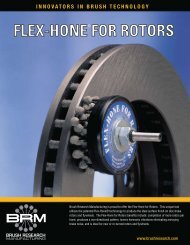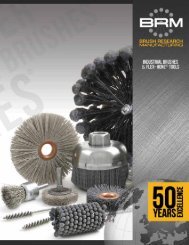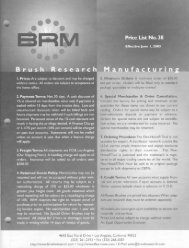Common Practices In CYLINDER BORING, HONING, AND WALL ...
Common Practices In CYLINDER BORING, HONING, AND WALL ...
Common Practices In CYLINDER BORING, HONING, AND WALL ...
You also want an ePaper? Increase the reach of your titles
YUMPU automatically turns print PDFs into web optimized ePapers that Google loves.
There has been a lot of replacement of sleeves. Our local agency has<br />
discovered that before delivering the new bike or replacing new sleeves,<br />
that Flex-Honing the cylinder has cured this fault. This is perhaps due to<br />
the old thinking of a coarse finish to begin with. Excessive friction creating<br />
excessive heat between the piston rings and the cylinder wall undoubtedly<br />
caused the warpage, and may also have annealed the rings.<br />
CLEANING <strong>WALL</strong>S AFTER <strong>HONING</strong><br />
If you are going to leave the crankshaft in, then of course be sure to mask<br />
off the journals. Some guys even cut an old rubber beach ball in half and<br />
push down into the bottom to catch the dirt. But catch it. That is why we<br />
recommend a light-weight oil, to lubricate and increase the life of the hone,<br />
to absorb the heat and prevent hardening of the metal, and to catch and<br />
hold the metal grindings, the abrasives that have chipped and been cast off<br />
and the other contaminants. We have compounded a Flex-Hone Processing<br />
Oil. It contains cutting oil, lapping oil, a wetting agent, a rust remover, a<br />
super lubricant, and the same stuff they would put in toothpaste to pick and<br />
hold all the “bread crumbs.” A few drops will do. But whatever you use,<br />
PLEASE DON’T use a solvent, kerosene, or diesel oil. They penetrate into the<br />
What is known as the “Flex-Hone Process”<br />
BEFORE<br />
wall finish and will fill the valleys of the finish with all the contaminants you<br />
want to get rid of. Also, NOT only should you not use<br />
solvents to hone with, you should NOT use them<br />
to wash out your cylinder for the same reason.<br />
After the honing job, just don’t wipe it out with an<br />
oily rag and smear the abrasive into the surface.<br />
<strong>In</strong>stead, use a good brush and some (preferably)<br />
hot water and some soap or detergent, and wash<br />
it out until the foam stays white. Then wipe it<br />
with a paper or cloth towel until the cloth or paper<br />
towel stays clean and white. Then dry it out so it<br />
won’t rust, and protect it with a swabbing of light<br />
oil.<br />
QUALITY CONTROL - MANUFACTURING<br />
SPECIFICATIONS<br />
When a new engine is being developed, somewhere in design engineering,<br />
somebody decides on the cylinder wall finish. It goes on the print, and<br />
becomes law. Manufacturing sets it up with the equipment that they have,<br />
quality control often checks in the beginning, but when things become<br />
routine…..<br />
As an example, we got 9 air-cooled two strokes right off the shelf, single<br />
cylinder, aluminum alloy with chromed cylinders. We ran them on a surface<br />
analyzer. We could only check the surface finish from the crank end as it<br />
was a closed jug and the stylus would not reach up to the top of the cylinder<br />
(plug end). The readings were:<br />
Cyl.<br />
No.<br />
FINISH<br />
A A µm<br />
Figure 10<br />
OUT OF ROUND<br />
Top<br />
Bottom<br />
<strong>In</strong>ches mm <strong>In</strong>ches mm<br />
1 5-50 .127-1.27 .0008 .0203 .0004 .0102<br />
2 8-15 .203-.381 .0015 .0381 .0005 .0127<br />
3 5-10 .127-.254 .0017 .0432 .0002 .0051<br />
4 7-15 .178-.381 .0005 .0127 .0007 .0178<br />
5 5-50 .127-.1.27 .0014 .0356 .0005 .0127<br />
6 6-12 .152-.305 .0005 .0127 .0003 .0076<br />
7 5-10 .127-.254 .0025 .0635 .0023 .0584<br />
AFTER<br />
Their desired finish was 7-10 (.178-, .254 µm Ra).<br />
We sawed the top off the one of the cylinders and found a finish of 1-2 AA<br />
at the top of the ring travel.





